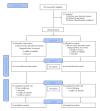Understanding the Social Networks That Form within the Context of an Obesity Prevention Intervention
- PMID: 22655175
- PMCID: PMC3359823
- DOI: 10.1155/2012/749832
Understanding the Social Networks That Form within the Context of an Obesity Prevention Intervention
Abstract
Background. Antiobesity interventions have generally failed. Research now suggests that interventions must be informed by an understanding of the social environment. Objective. To examine if new social networks form between families participating in a group-level pediatric obesity prevention trial. Methods. Latino parent-preschool child dyads (N = 79) completed the 3-month trial. The intervention met weekly in consistent groups to practice healthy lifestyles. The control met monthly in inconsistent groups to learn about school readiness. UCINET and SIENA were used to examine network dynamics. Results. Children's mean age was 4.2 years (SD = 0.9), and 44% were overweight/obese (BMI ≥ 85th percentile). Parents were predominantly mothers (97%), with a mean age of 31.4 years (SD = 5.4), and 81% were overweight/obese (BMI ≥ 25). Over the study, a new social network evolved among participating families. Parents selectively formed friendship ties based on child BMI z-score, (t = 2.08; P < .05). This reveals the tendency for mothers to form new friendships with mothers whose children have similar body types. Discussion. Participating in a group-level intervention resulted in new social network formation. New ties were greatest with mothers who had children of similar body types. This finding might contribute to the known inability of parents to recognize child overweight.
Figures


References
-
- Ogden CL, Carroll MD, Curtin LR, Lamb MM, Flegal KM. Prevalence of high body mass index in US children and adolescents, 2007-2008. Journal of the American Medical Association. 2010;303(3):242–249. - PubMed
-
- Jeffery RW, Linde J. Population approaches to obesity prevention. In: Crawford D, Jeffery RW, editors. Obesity Prevention and Public Health. New York, NY, USA: Oxford University Press; 2005.
-
- Birch LL, Ventura AK. Preventing childhood obesity: what works. International Journal of Obesity. 2009;33(1):S74–S81. - PubMed
-
- Ebbeling CB, Ludwig DS. Pediatric obesity prevention initiatives: more questions than answers. Archives of Pediatrics and Adolescent Medicine. 2010;164(11):1067–1069. - PubMed
Grants and funding
LinkOut - more resources
Full Text Sources
Miscellaneous

